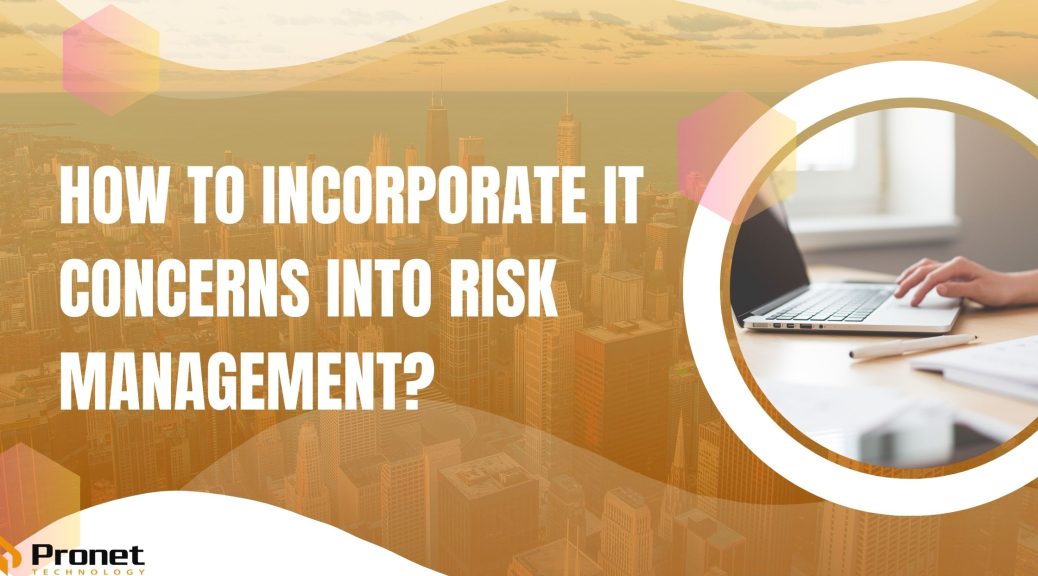How to incorporate IT concerns into risk management

Incorporating IT concerns into your company’s risk management strategy is essential to protecting your assets and minimising potential losses. Here are some steps to incorporate IT concerns into your risk management:
Identify
The first step is to identify your company’s top IT risks that could impact your business operations, such as data breaches, hardware failure and cyberattacks. We published a blog post detailing some of the top concerns of small and medium-sized businesses earlier this week, so brainstorm with your stakeholders as well as your Managed Service Provider what these are, then read our post to see if you’re missing anything. You can read that post here.
Other than this, you will want to identify IT use within your business. This includes internet banking, taxation, cloud hosting services, online stores and apps, social media, Point of Sale (POP), VOIP (Voice over Internet), NBN, mobile phones and computers. This helps you fully outline and visualise the amount of IT your organisation is truly reliant on as well as realise just how easily the risk of serious IT failure can impact your business’ trading.
Part of your risk management processes should be assessing the likelihood of these IT concerns occurring as well as the potential impacts they would have on your business operations, revenue and reputation. This helps you prioritise your efforts and resources to address the most critical IT risks.
If you have one, contact your IT provider
Once you’ve identified those, ask your IT provider about the strategies they have in place to prevent these risks from happening. If they don’t have anything or only have limited processes, you might want to discuss the reasons why this is and if you are not satisfied with their response, look at switching providers. When cyberattacks can cause your company to be in breach of The Privacy Act and when the Australian Government is likely to mandate strategies like the Essential Eight being implemented into businesses, it’s on you to ensure you’re well protected.

If you don’t have one, get an MSP
We have written articles about why an MSP is essential to your business, so make sure to read those if you don’t have one. When signing with an MSP, they set up practical IT risk management systems within your business. These include securing computers, servers and wireless networks, using anti-virus and anti-spyware protection and firewalls, updating software to the latest versions, using data backups, securing your passwords, implementing two-factor authentication, training staff in IT policies and procedures, using Secure Socket Layer (SSL) on websites and helping you understand the legal obligations for your business.
Your business needs to ensure you have risk mitigation strategies in place to address the IT risks you have identified, and this should be in collaboration with your IT service provider. The Essential Eight strategies can become incredibly helpful in this stage as they detail a framework for your business to follow that is comprehensive and will keep your company safe.
The Prevention, Preparedness, Response, Recovery (PPRR) risk management model helps you identify risks to include in your business’ policies and procedures. You can implement policies such as the policy for use of software, bring your own device policy and information technology security policy, which gives staff something to follow to reduce or prevent IT risks.
Insure your business against IT risks
While strategies put in place are to prevent IT risks, there is always a chance that they will still happen and unfortunately, with so many variables outside your control, it’s no longer a matter of if, but when. This is why business insurance may provide another way to reduce risk to your business. It can help reduce company costs that could have you closing your business or paying a large amount of money. You might want to look into Business Interruption, Electronic Breakdown, IT Liability or Cyber Insurance.

Monitoring and Reviews
Your MSP should then be regularly monitoring and reviewing these IT risks to ensure that the risk mitigation strategies that were put in place are effective and up-to-date. This may involve conducting vulnerability assessments, penetration testing and reviewing incident response plans. Don’t just leave this all to the MSP though, as when you receive your reports from the provider, make sure you are also going over these thoroughly to ensure that you are receiving the level of service from the provider that you agreed to and that you are satisfied that the risks are being properly monitored.
Communication
Communicate IT risks and risk management strategies with relevant stakeholders, such as employees, customers, partners and investors. If need be, involve your IT service provider in these meetings so that everyone is on board and so that you are both achieving the longevity goals you have set. This helps to build trust and demonstrate that your business takes IT risks seriously. You can even hold cyber security training for new staff and update staff and training manuals when new risks are introduced through meetings or company newsletters.
All in all, it’s important that, as a business, you continuously improve your IT risk management approach by learning from past incidents and industry best practices. This helps to ensure that your business remains resilient to new and emerging IT risks.
By incorporating IT concerns into risk management, businesses can ensure that their IT infrastructure is secure, reliable and efficient, reducing the likelihood of IT-related incidents and minimising their impact when they do occur. Like it or not, it’s technology, so something will likely occur, but risk management strategies ensure that your business is not damaged when it does.



